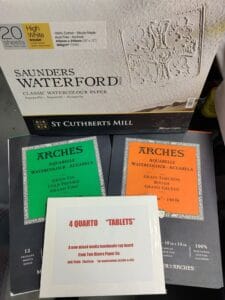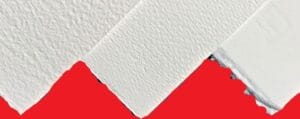Preparation for producing good results with this delicate and fluid medium is very different to the techniques I have discussed in the last two blogs. Watercolour paint requires a surface which can absorb and hold water without buckling or deteriorating. It is all about the paper.
Let’s first look at the weight. Measured in grammes (grams for my US readers) per square metre/meter (gsm) or pounds per ream (lb) – a ream being 500 sheets – the most common paper weights are:
190 gsm (90lb) Light weight paper, liable to buckle, stretching it is recommended.
300 gsm (140lb) Good weight paper works with lighter use of water.
425 gsm (200lb) Excellent weight paper, liberal use of water works well.
535 gsm (250lb) Excellent weight paper for heavy use of water.
640 gsm (300lb) Throw large amounts of water at it and it will be good.
850 gsm (400lb) Basically, it takes as much water as you want.

Next is the texture. There are three common surfaces: hot press, which is smooth and ideal for painters producing works with fine detail like botanical studies and controlled washes.
Cold pressed is the most commonly used watercolour paper. It is very versatile and slightly textured. The levels of texture vary between different brands.
Rough is a highly textured paper which is ideal for loose styles and expressive works.
When choosing watercolour paper, 100% cotton is the best quality and the most durable. Student grade papers are cheaper but will not last and you are likely to be disappointed. Always buy the best paper you can afford.
If you have not stretched watercolour paper before your best bet is probably to go onto YouTube and watch a few videos on how best to do it. Alternatively, these days you can buy watercolour canvases. These are pre primed, allowing for the water to move on the surface and they don’t need stretching.
Another option which means you do not need to prepare the surface is Yupo paper. This “paper” is actually synthetic (it’s made from 100% polypropylene) and non-absorbent. The paint stays fluid for a long time on this paper and you can create interesting effects when working, reworking or rewetting the paper, making this a fun paper to experiment with.

When creating watercolour paintings, you use the paper to create white meaning you don’t use white paint. However, when going for fine detail it is often a good idea to use masking fluid. This liquid latex is applied (use a cheap or silicone brush) and allowed to dry fully before adding water and colour. Only remove it once the painting is dry.
Watercolour paints can be also used on other surfaces, but it is all in the preparation. If you want to try watercolours on other surfaces, e.g. wood/board, glass, unprimed canvas or even Perspex, you will need to use a special watercolour primer. This special primer creates a surface which works with watercolours.
If you have enjoyed reading this blog, you can sign up to my weekly blog https://alisongsaunders.co.uk/blog/ or sign up to my monthly newsletter to find out more about me and what I am doing. https://alisongsaunders.co.uk/newsletter-signup/
NB I do not get paid to endorse any people or brands mentioned in my blogs.
If you enjoyed this post, please like, share and follow me. Sharing, liking and following raises the algorithms in my favour.
Thank you for your support.
